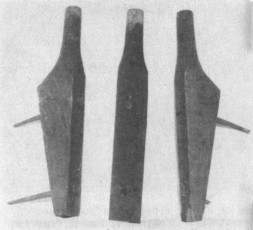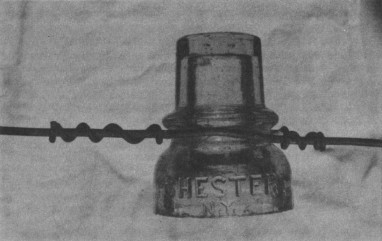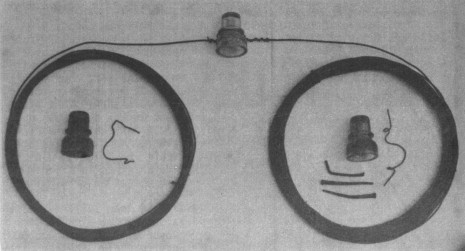How To Dig A Threadless - Part B
by Ray Klingensmith
Reprinted from "INSULATORS - Crown Jewels of the Wire", August 1983, page 18
Out Diggin'
Now that you have done all the
homework needed, and have all your equipment, it's time to head out on the line.
Let's start with a railroad line first. If you've figured out for sure what side
of the tracks the original line ran on, you're all set. If you haven't, there
are some things you will have to do. Walk one side of the tracks and then the
other, looking for fragments on the surface. (It's quite possible there were
threadless on both sides, so don't overlook the other side just because you
believe you have it figured out.) If you can't find any fragments, check for
small depressions in the ground where an old pole could have been at one time,
that has since rotted away, leaving a hole which may be partially filled in with
dirt. Poke your "digger" handle into any holes or suspicious looking
places. If it goes down three or four feet, you might have a "pole
hole". Some early line builders placed stones and rocks at the base of the
pole to help reinforce it, so watch for small "stone rings". If you
have a metal detector, try to locate some tie wires or spikes. There is an awful
lot of scrap metal along the railroads, but you will eventually find the old
"remains". Best place to use your detector is in an area where the
railroad went through a rock cut or around a hillside. Use your detector where
the telegraph line would have gone up the hill above the tracks. There will be
very little scrap metal in a place like that. Also, if you are looking for
fragments, or whole ones on the surface, one of the best places is on the
steeper hillsides. There is less chance of the insulators being buried in those
places because there will be less vegetation decaying over the years and
covering anything, plus the fact that the surface is always changing from
erosion and other factors, exposing your relics. Also remember that most line
builders would put a pole just at the edge of a ravine or hillside when making
crossings over them. (See drawing below.)

These are always promising spots to
look at. Do some raking several yards downhill, and work your way up to where
the pole probably stood. If you have really done your home work, you will know
where there may have been some track "re routes" over the years. The
most likely places to check are anywhere there are tunnels, very large fills, or
bridges. You have to remember that most railroad lines were used quite heavily
in the early days. When a new bridge was put in, or a large fill replaced a
bridge, etc., they probably didn't shut the line down for several days. Instead,
they kept the old track open and in use, and built a new structure several yards
away. When the new one was complete, they hooked the rails into the existing
track and abandoned or removed the old section. (See drawing below.) These are
very good places to look.

If there has been any dozing or track upgrading on the
line, the old section is usually far enough away that it didn't get disturbed.
Spend some time on these sections! Pay close attention to the ground and land
features to try to determine whether there has been extensive dozing on the
right of way wherever you look. Fragments can be found in dozed areas, but
digging areas are usually better if they haven't been "roto rooted".
That's why the areas that were rerouted in later years are so appealing. There
have been much fewer changes on those older, no longer used sections.
You might
want to check some of the old railroad depots or buildings (with permission, of
course) where the telegraph offices once were. In many cases the line wire
entered the building at the top, came through the wall into the attic, and
then down through the attic floor to the telegraph operator. Many good
threadless have come out of these attics. The three threadless side brackets in
Figure D came out of an original NY& ERR depot three years ago. I found them
still nailed to rafters where a railroad employee told me they would be.
Unfortunately, another railroad employee collector had removed the glass
treasures a decade earlier. But in reality, he left the rarest relic behind for
me! How many other threadless side brackets have you seen from that history rich
railroad?

Figure D.
Threadless brackets
from a NY&ERR depot (circa 1849-1851). There is evidence of the old
insulators having been used on these, as the upper portion of the pin is
compressed where the glass fit snugly over it. |
As I write this, I'm sure there are some rare threadless waiting to
be found in some old attic. (Once again this is a little different story than
walkin' the tracks. Most railroad people don't get too upset with your diggin's,
but attic huntin' without permission is a real no-no.)
Lines Along Roads.
These
lines, although similar in many ways to the railroad lines, can be quite a
challenge. Whereas the width of the railroad right of way usually didn't change,
most wagon roads important enough to have telegraph lines on them back in the
early days were important enough in later years to be more heavily used and
widened, and most are today paved, upgraded roadways. For that reason lines
along old roads can be quite disappointing. There are, however, some old roads
which were later abandoned, rerouted, or which never became one of the busy
routes of modern day. These old routes can be very rewarding, as there has been
very little disturbance on them over the years. In this type of hunting a metal
detector will probably be your best friend. These lines are among the easiest to
follow, as there are almost always some old road maps available that show the
old course.
Cross Country Routes.
This is by far the ultimate challenge. With no
road or railroad to follow, staying on course is very difficult. If you know the
general location of the line, a lot of patience and serious looking can yield
some clues as to where it once was. There are several things to remember. If the
line ran from one town to another, or any point to another, the builders
probably took the shortest (straightest) route the terrain would allow. In a
fairly level area a straight line would be very logical, unless there was some
reason to go off one direction or another. In knowing points a line went to, it
would be easy to assume it went in a straight line between them. But keep in
mind there may have been a town, fort, mine or other factor involved that you
are unaware of that gave them reason to build "off course". If you
have relatively good success finding "remains" in most areas and later
get into a section and find no traces at all, it probably means the line was
located elsewhere. But don't give up too quick on the initial probable route.
Different wrecking crews may have cleaned out one area better than others.
Perhaps area residents gathered poles, wire, nails, etc. in some areas, and in
others did not. It all depends on the line you are looking on. After a lot of
experience you usually get a "feel" for what's going on, especially if
you work one line in particular most of the time.

Close up of the Chester. It's
been tied to the line wire for 117 years. The insulator could have been removed
for safe transport, and tied back on after getting home, but that to me would
have taken a little out of the history of the piece. So out of the bush it came,
strapped to my backpack, just as you see it. |

Several feet of wire was coiled on
either side of the insulator after being pulled from the forest floor, covered
by roots, leaves and pine needles. The green Tillotson to the left was found
after its original tie wire was located. The aqua Tillotson at right and
hardware shown with it has an interesting story. The spikes and tie wire were
found one day. Due to the ground being frozen, it wasn't until a week later that
the area could be dug, and the mint condition Tilly was found. I'm sure a
gigantic horseshoe found at the site had something to do with adding some
determination required for the dig. Who ways horseshoes don't bring good luck? |
|
